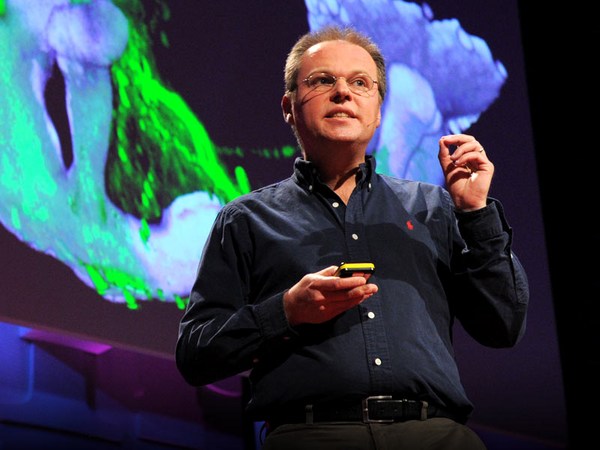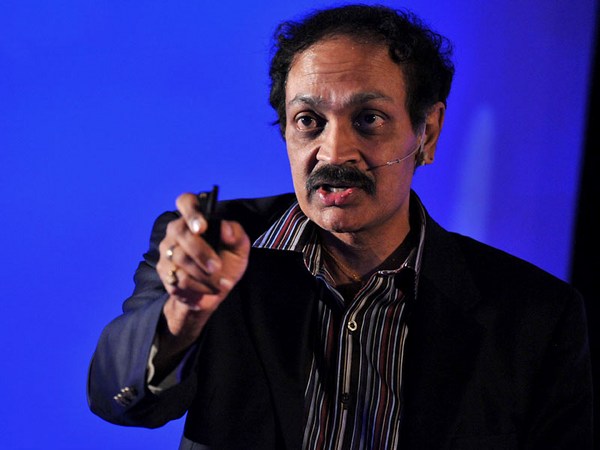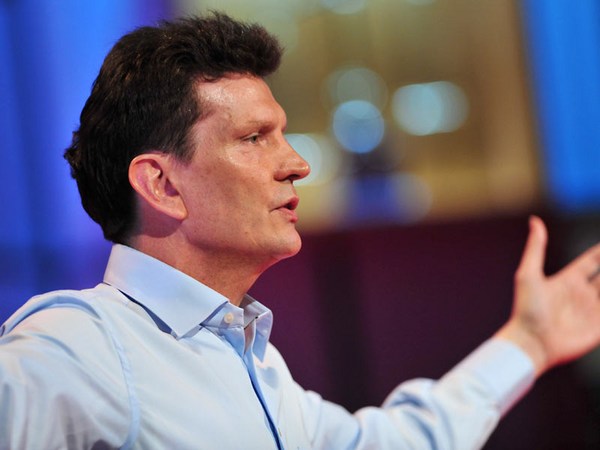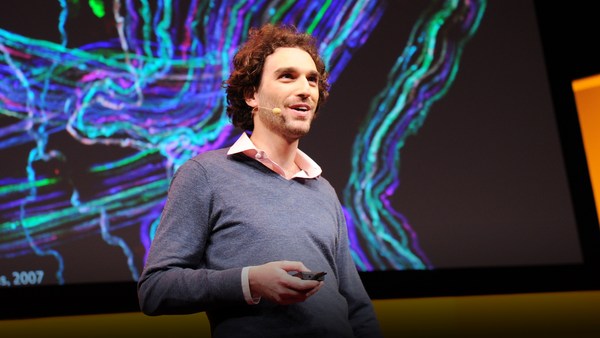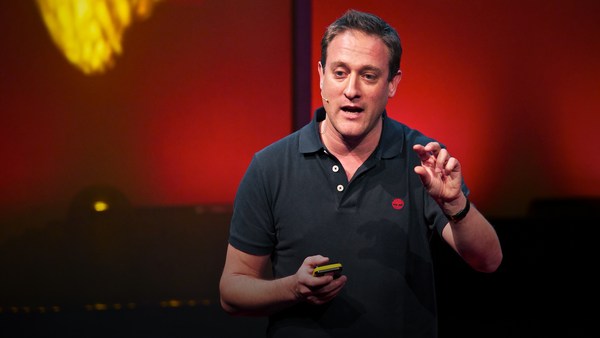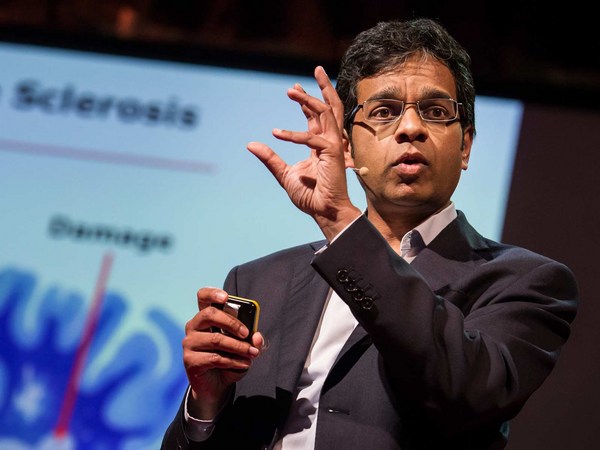Think about your day for a second. You woke up, felt fresh air on your face as you walked out the door, encountered new colleagues and had great discussions and felt in awe when you found something new. But I bet there's something you didn't think about today, something so close to home, you probably don't think about it very often at all. And that's that all those sensations, feelings, decisions and actions are mediated by the computer in your head called your brain.
Now, the brain may not look like much from the outside -- a couple pounds of pinkish-gray flesh, amorphous. But the last 100 years of neuroscience have allowed us to zoom in on the brain and to see the intricacy of what lies within. And they've told us that this brain is an incredibly complicated circuit made out of hundreds of billions of cells called neurons. Now, unlike a human-designed computer, where there's a fairly small number of different parts, and we know how they work because we humans designed them, the brain is made out of thousands of different kinds of cells, maybe tens of thousands. They come in different shapes; they're made out of different molecules; they project and connect to different brain regions. They also change in different ways in different disease states.
Let's make it concrete. There's a class of cells, a fairly small cell, an inhibitory cell, that quiets its neighbors. It's one of the cells that seems to be atrophied in disorders like schizophrenia. It's called the basket cell. And this cell is one of the thousands of kinds of cell that we're learning about. New ones are being discovered every day. As just a second example: these pyramidal cells, large cells, can span a significant fraction of the brain. They're excitatory. And these are some of the cells that might be overactive in disorders such as epilepsy. Every one of these cells is an incredible electrical device. They receive inputs from thousands of upstream partners and compute their own electrical outputs, which then, if they pass a certain threshold, will go to thousands of downstream partners. And this process, which takes just a millisecond or so, happens thousands of times a minute in every one of your 100 billion cells, as long as you live and think and feel.
So how are we going to figure out what this circuit does? Ideally, we could go through this circuit and turn these different kinds of cell on and off and see whether we could figure out which ones contribute to certain functions and which ones go wrong in certain pathologies. If we could activate cells, we could see what powers they can unleash, what they can initiate and sustain. If we could turn them off, then we could try and figure out what they're necessary for. And that's the story I'm going to tell you about today. And honestly, where we've gone through over the last 11 years, through an attempt to find ways of turning circuits and cells and parts and pathways of the brain on and off, both to understand the science and also to confront some of the issues that face us all as humans.
Now, before I tell you about the technology, the bad news is that a significant fraction of us in this room, if we live long enough, will encounter, perhaps, a brain disorder. Already, a billion people have had some kind of brain disorder that incapacitates them. The numbers don't do it justice, though. These disorders -- schizophrenia, Alzheimer's, depression, addiction -- they not only steal away our time to live, they change who we are. They take our identity and change our emotions and change who we are as people.
Now, in the 20th century, there was some hope that was generated through the development of pharmaceuticals for treating brain disorders. And while many drugs have been developed that can alleviate symptoms of brain disorders, practically none of them can be considered to be cured. In part, that's because, if you think about it, we're bathing the brain in a chemical -- this elaborate circuit, made of thousands of different kinds of cell -- is being bathed in a substance. That's also why most of the drugs, not all, on the market can present some kind of serious side effect too.
Now some people have gotten some solace from electrical stimulators that are implanted in the brain, for Parkinson's disease or cochlear implants. These have indeed been able to bring some kind of remedy to people with certain kinds of disorders. But electricity also will go in all directions -- the path of least resistance -- which is where that phrase, in part, comes from, and will also affect normal circuits, as well as the abnormal ones you want to fix. So again, we're sent back to the idea of ultraprecise control: Could we dial in information precisely where we want it to go?
So, when I started in neuroscience 11 years ago -- I had trained as an electrical engineer and a physicist -- the first thing I thought about was, if these neurons are electrical devices, all we need to do is to find some way of driving those electrical changes at a distance. If we could turn on the electricity in one cell but not its neighbors, that'd give us the tool to activate and shut down these different cells to figure out what they do and how they contribute to the networks in which they're embedded. It would also allow us to have the ultraprecise control we need to fix the circuit computations that have gone awry.
Now, how are we going to do that? Well, there are many molecules that exist in nature which are able to convert light into electricity. You can think of them as little proteins that are like solar cells. If we install these molecules in neurons somehow, then these neurons would become electrically drivable with light, and their neighbors, which don't have this molecule, would not. There's one other magic trick you need to make this happen: the ability to get light into the brain. The brain doesn't feel pain. Taking advantage of all the effort that's gone into the internet, telecommunications, etc., you can put optical fibers connected to lasers to activate -- in animal models, for example, in preclinical studies -- these neurons and see what they do.
So how do we do this? Around 2004, in collaboration with Georg Nagel and Karl Deisseroth, this vision came to fruition. There's a certain alga that swims in the wild, and it needs to navigate towards light in order to photosynthesize optimally. And it senses light with a little eyespot, which works not unlike how our eye works. In its membrane, or its boundary, it contains little proteins that indeed can convert light into electricity. These molecules are called channelrhodopsins. And each of these proteins acts just like that solar cell that I told you about. When blue light hits it, it opens a little hole and allows charged particles to enter the eyespot; that allows this eyespot to have an electrical signal, just like a solar cell charging a battery.
So what we need to do is take these molecules and somehow install them in neurons. And because it's a protein, it's encoded for in the DNA of this organism. So all we've got to do is take that DNA, put it into a gene therapy vector, like a virus, and put it into neurons. And this was a very productive time in gene therapy, and lots of viruses were coming along, so this turned out to be fairly simple. Early in the morning one day in the summer of 2004, we gave it a try, and it worked on the first try. You take this DNA and put it into the neuron. The neuron uses its natural protein-making machinery to fabricate these little light-sensitive proteins and install them all over the cell, like putting solar panels on a roof. And the next thing you know, you have a neuron which can be activated with light. So this is very powerful.
One of the tricks you have to do is figure out how to deliver these genes to the cells you want and not all the other neighbors. And you can do that; you can tweak the viruses so they hit some cells and not others. And there's other genetic tricks you can play in order to get light-activated cells. This field has now come to be known as "optogenetics." And just as one example of the kind of thing you can do, you can take a complex network, use one of these viruses to deliver the gene just to one kind of cell in this dense network. And then when you shine light on the entire network, just that cell type will be activated.
For example, let's consider that basket cell I told you about earlier, the one that's atrophied in schizophrenia and the one that is inhibitory. If we can deliver that gene to these cells -- they won't be altered by the expression of the gene, of course -- then flash blue light over the entire brain network, just these cells are going to be driven. And when the light turns off, these cells go back to normal; there don't seem to be adverse events. Not only can you study what these cells do, what their power is in computing in the brain, you can also use this to try to figure out if we could jazz up the activity of these cells if indeed, they're atrophied.
I want to tell you some short stories about how we're using this both at the scientific clinical and preclinical levels. One of the questions that we've confronted is: What signals in the brain mediate the sensation of reward? Because if you could find those, those would be some of the signals that could drive learning; the brain will do more of what got that reward. These are also signals that go awry in disorders such as addiction. So if we could figure out what cells they are, we could maybe find new targets for which drugs can be designed or screened against or maybe places where electrodes could be put in for people who have severe disability. To do that, we came up with a very simple paradigm in collaboration with the Fiorillo group, where, if the animal goes to one side of this little box, it gets a pulse of light. And we'll make different cells in the brain sensitive to light. If these cells can mediate reward, the animal should go there more and more. And that's what happens.
The animal goes to the right-hand side and pokes his nose there and gets a flash of blue light every time he does it. He'll do that hundreds of times. These are the dopamine neurons, in some of the pleasure centers in the brain. We've shown that a brief activation of these is enough to drive learning. Now we can generalize the idea. Instead of one point in the brain, we can devise devices that span the brain, that can deliver light into three-dimensional patterns -- arrays of optical fibers, each coupled to its own independent miniature light source. Then we can try to do things in vivo that have only been done to date in a dish, like high-throughput screening throughout the entire brain for the signals that can cause certain things to happen or that could be good clinical targets for treating brain disorders.
One story I want to tell you about is: How can we find targets for treating post-traumatic stress disorder, a form of uncontrolled anxiety and fear? One of the things that we did was to adopt a very classical model of fear. This goes back to the Pavlovian days. It's called Pavlovian fear conditioning, where a tone ends with a brief shock. The shock isn't painful, but it's a little annoying. And over time -- in this case, a mouse, which is a good animal model, commonly used in such experiments -- the animal learns to fear the tone. It will react by freezing, sort of like a deer in the headlights. Now the question is: What targets in the brain can we find that allow us to overcome this fear? So we play that tone again, after it's been associated with fear. But we activate different targets in the brain, using that optical fiber array I showed on the previous slide, in order to try and figure out which targets can cause the brain to overcome that memory of fear.
This brief video shows you one of these targets that we're working on now. This is an area in the prefrontal cortex, a region where we can use cognition to try to overcome aversive emotional states. The animal hears a tone. A flash of light occurs. There's no audio, but you see that the animal freezes -- the tone used to mean bad news. There's a little clock in the lower left-hand corner. You can see the animal is about two minutes into this. This next clip is just eight minutes later. And the same tone is going to play, and the light is going to flash again. OK, there it goes. Right ... now. And now you can see, just 10 minutes into the experiment, that we've equipped the brain, by photoactivating this area, to overcome the expression of this fear memory.
Over the last couple years, we've gone back to the tree of life, because we wanted to find ways to turn circuits in the brain off. If we could do that, this could be extremely powerful. If you can delete cells for a few milliseconds or seconds, you can figure out what role they play in the circuits in which they're embedded. We surveyed organisms from all over the tree of life -- every kingdom of life but animals; we see slightly differently. We found molecules called halorhodopsins or archaerhodopsins, that respond to green and yellow light. And they do the opposite of the molecule I told you about before, with the blue light activator, channelrhodopsin.
Let's give an example of where we think this is going to go. Consider, for example, a condition like epilepsy, where the brain is overactive. Now, if drugs fail in epileptic treatment, one of the strategies is to remove part of the brain, but that's irreversible, and there could be side effects. What if we could just turn off that brain for the brief amount of time until the seizure dies away, and cause the brain to be restored to its initial state, like a dynamical system that's being coaxed down into a stable state? This animation tries to explain this concept where we made these cells sensitive to being turned off with light, and we beam light in, and just for the time it takes to shut down a seizure, we're hoping to be able to turn it off. We don't have data to show you on this front, but we're very excited about this.
I want to close on one story, which we think is another possibility, which is that maybe these molecules, if you can do ultraprecise control, can be used in the brain itself to make a new kind of prosthetic, an optical prosthetic. I already told you that electrical stimulators are not uncommon. Seventy-five thousand people have Parkinson's deep-brain stimulators implanted, maybe 100,000 people have cochlear implants, which allow them to hear. Another thing -- you've got to get these genes into cells. A new hope in gene therapy has been developed, because viruses like the adeno-associated virus -- which probably most of us around this room have; it doesn't have any symptoms -- have been used in hundreds of patients to deliver genes into the brain or the body. And so far, there have not been serious adverse events associated with the virus.
There's one last elephant in the room: the proteins themselves, which come from algae, bacteria and funguses and all over the tree of life. Most of us don't have funguses or algae in our brains, so what will our brain do if we put that in? Will the cells tolerate it? Will the immune system react? It's early -- these haven't been done in humans yet -- but we're working on a variety of studies to examine this. So far, we haven't seen overt reactions of any severity to these molecules or to the illumination of the brain with light. So it's early days, to be upfront, but we're excited about it.
I wanted to close with one story, which we think could potentially be a clinical application. Now, there are many forms of blindness where the photoreceptors -- light sensors in the back of our eye -- are gone. And the retina is a complex structure. Let's zoom in on it so we can see it in more detail. The photoreceptor cells are shown here at the top. The signals that are detected by the photoreceptors are transformed via various computations until finally, the layer of cells at the bottom, the ganglion cells, relay the information to the brain, where we see that as perception. In many forms of blindness, like retinitis pigmentosa or macular degeneration, the photoreceptor cells have atrophied or been destroyed. Now, how could you repair this? It's not even clear that a drug could cause this to be restored, since there's nothing for the drug to bind to. On the other hand, light can still get into the eye. The eye is still transparent and you can get light in. So what if we could take these channelrhodopsins and other molecules and install them on some of these other spared cells and convert them into little cameras? And because there are so many of these cells in the eye, potentially, they could be very high-resolution cameras.
This is some work that we're doing, led by one of our collaborators, Alan Horsager at USC, and being sought to be commercialized by a start-up company, Eos Neuroscience, which is funded by the NIH. What you see here is a mouse trying to solve a six-arm maze. There's a bit of water to motivate the mouse to move or he'll just sit there. The goal of this maze is to get out of the water and go to a little platform that's under the lit top port. Mice are smart, so this one solves the maze eventually, but he does a brute-force search. He's swimming down every avenue until he finally gets to the platform. He's not using vision to do it. These different mice are different mutations that recapitulate different kinds of blindness that affect humans. So we're being careful in trying to look at these different models so we come up with a generalized approach.
So how can we solve this? We'll do exactly what we outlined in the previous slide. We'll take these blue light photo sensors and install them onto a layer of cells in the middle of the retina in the back of the eye and convert them into a camera -- just like installing solar cells all over those neurons to make them light-sensitive. Light is converted to electricity on them. So this mouse was blind a couple weeks before this experiment and received one dose of this photosensitive molecule on a virus. And now you can see, the animal can indeed avoid walls and go to this little platform and make cognitive use of its eyes again. And to point out the power of this: these animals can get to that platform just as fast as animals that have seen their entire lives. So this preclinical study, I think, bodes hope for the kinds of things we're hoping to do in the future.
We're also exploring new business models for this new field of neurotechnology. We're developing tools and sharing them freely with hundreds of groups all over the world for them to study and try to treat different disorders. Our hope is that by figuring out brain circuits at a level of abstraction that lets us repair them and engineer them, we can take some of these intractable disorders I mentioned earlier, practically none of which are cured, and in the 21st century, make them history.
Thank you.
(Applause)
Juan Enriquez: So some of this stuff is a little dense.
(Laughter)
But the implications of being able to control seizures or epilepsy with light instead of drugs and being able to target those specifically is a first step. The second thing that I think I heard you say is you can now control the brain in two colors, like an on-off switch.
Ed Boyden: That's right.
JE: Which makes every impulse going through the brain a binary code.
EB: Right. With blue light, we can drive information, and it's in the form of a one. And by turning things off, it's more or less a zero. Our hope is to eventually build brain coprocessors that work with the brain so we can augment functions in people with disabilities.
JE: And in theory, that means that, as a mouse feels, smells, hears, touches, you can model it out as a string of ones and zeros.
EB: Yeah. We're hoping to use this as a way of testing what neural codes can drive certain behaviors and certain thoughts and certain feelings and use that to understand more about the brain.
JE: Does that mean that someday you could download memories and maybe upload them?
EB: That's something we're starting to work on very hard. We're now working on trying to tile the brain with recording elements, too, so we can record information and then drive information back in -- sort of computing what the brain needs in order to augment its information processing.
JE: Well, that might change a couple things. Thank you.
EB: Thank you.
(Applause)
